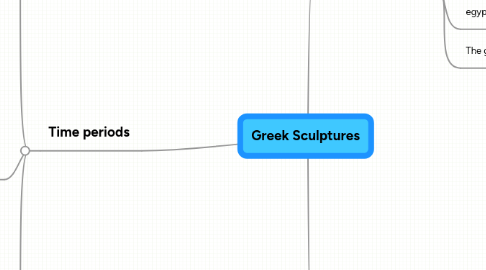
1. Time periods
1.1. Classic
1.1.1. Style
1.1.1.1. freedom of movement
1.1.1.2. celebrates mankind
1.1.1.3. freedom of expression
1.1.1.3.1. solemn facial expressions
1.1.1.3.2. Greek artists created expression based on observations of humans around them
1.1.1.4. independence
1.1.1.5. free flowing
1.1.1.5.1. real life
1.1.2. 480-323 BCE
1.1.2.1. considered the golden age for greek art
1.1.3. Materials
1.1.3.1. marble
1.1.3.2. bronze
1.1.4. concerned with display and the ideal perfection.
1.1.5. contrapposto stance
1.2. Archaic
1.2.1. Archaic art gave way to realistic figures
1.2.2. 600-480 BCE
1.2.3. Mid 7th century BCE
1.2.3.1. sculptures went from smaller scale with soft stone to larger scale with harder stone
1.2.4. materials
1.2.4.1. most archaic sculptures are made in stone
1.2.4.2. bronze also became popular
1.2.5. Men and Women sculptures
1.2.5.1. Kouros-male
1.2.5.1.1. Male and female statues dominated this time period.
1.2.5.1.2. Men were sculpted naked
1.2.5.2. Kore-female
1.2.5.2.1. very stiff poses
1.2.5.2.2. women were sculpted in drapes
1.2.6. Styles
1.2.6.1. styles of this period became disadvantages
1.2.6.2. stillness and symmetry
1.2.6.3. slight smile
1.3. Hellenistic
1.3.1. 323-146 BCE
1.3.2. 3 of the Best known sculptures are from this period
1.3.2.1. Laocoon and His Sons,
1.3.2.2. Winged Victory of Samothrace
1.3.2.3. Venus de Milo
1.3.3. Terra cotta figurines
1.3.3.1. Molding techniques made it possible to create miniature statues and they could now have a large amount of detail.
1.3.4. children sculptures were very popular during this time period
1.3.5. concerned with inner emotions, and taking risks as an artist.
1.3.5.1. the artist explores reality
1.3.5.1.1. see art in different views
1.3.6. styles
2. Sculptures
2.1. The gods
2.1.1. Sculptures of the gods
2.2. Greek art and myths
2.2.1. 5th century B.C.E
